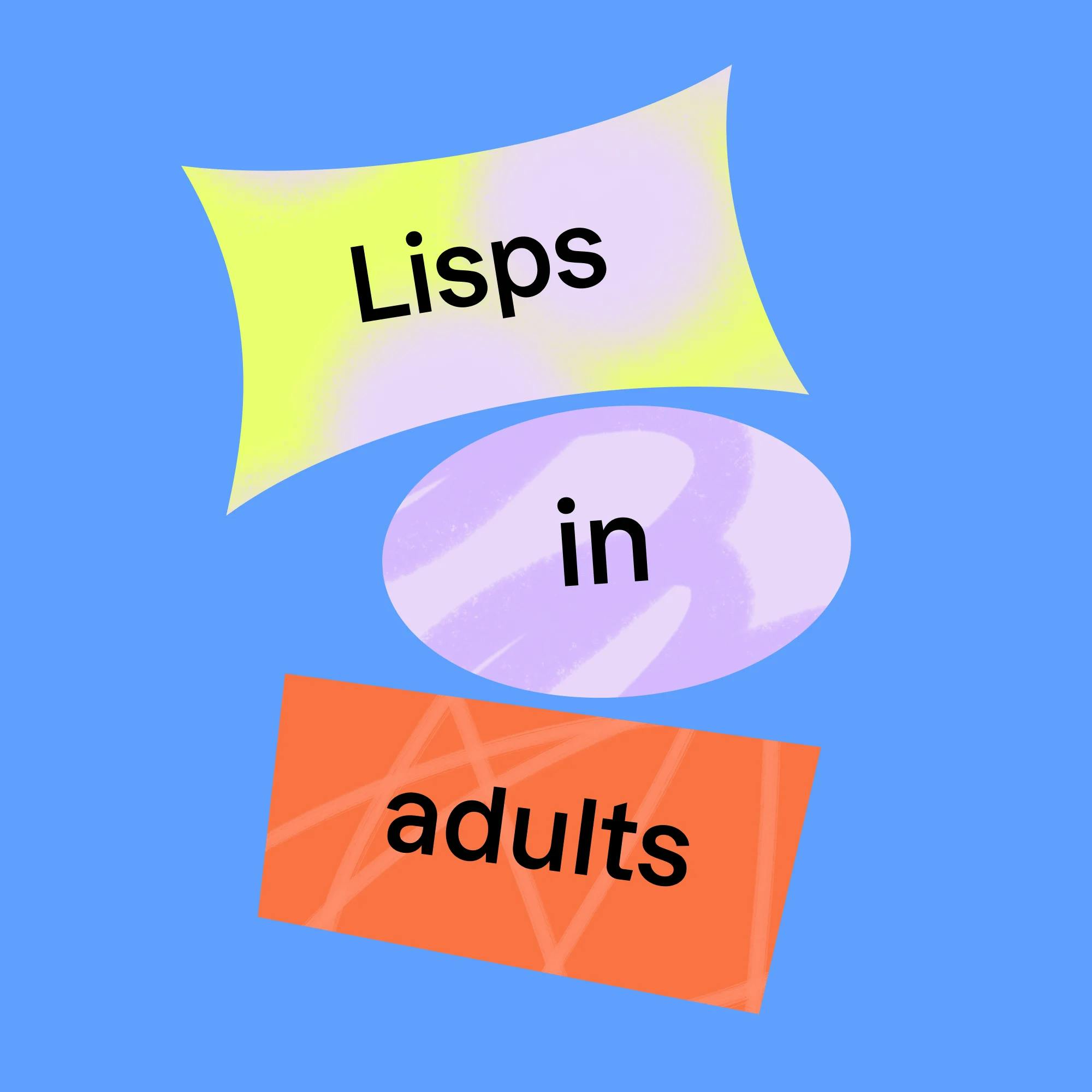You’ve likely heard the term “lisp” plenty of times. It’s typically used to describe a distorted way of pronouncing the /s/ and /z/ sounds. But did you know that there are different types of lisps? In this article, we discuss the lateral lisp: what it is, how it affects a person’s speech, and speech therapy exercises you can practice at home to improve a lisp.
Get matched with a speech therapist who's right for you
Get started nowWhat is a lisp?
A lisp is a speech condition that occurs in both children and adults. Lisps are some of the most common speech errors! It’s estimated that about 23% of people who receive speech therapy do so because of a lisp.
Lisps usually develop during childhood, and they can persist into the teenage years and adulthood when not treated. Although a lisp can make a person’s speech sound less mature or more difficult to understand, it can be corrected with guidance and practice.
What causes a lisp?
There are a few reasons the /s/ and /z/ sound are so tricky. The specific tongue positioning needed, as well as the frequency of this sound in the English language, make /s/ one of the harder sounds to learn.
With that being said, an incorrect motor pattern of tongue positioning and movement causes a lisp. Basically, when a person has a lisp, they are positioning their tongue in a way that blocks the airflow needed to make the /s/ and /z/ sounds. This distortion of airflow creates the lisping sound we are familiar with.
The reason for this incorrect tongue position isn’t always clear. Lisps can be caused by a variety of factors, including:
Learning to produce the /s/ and /z/ sounds incorrectly as a child
A jaw misalignment, or problems with a person’s jaw alignment
A tongue tie, which occurs when the tongue is attached to the bottom of the mouth and its movement is restricted, and which may result in a lateral lisp
A tongue thrust, in which the tongue protrudes forward (this can also impact feeding and swallowing)


The difference between the /s/ and /z/ sound
Before we go further, let’s cover some basics about correct /s/ and /z/ sound production. In this article, we use the /s/ production most often when providing examples. This is because the same tongue placement that’s used to make the /s/ sound is also used for /z/. The only difference is that our vocal cords don’t vibrate when we say the /s/ sound, whereas they are activated and vibrating when we say the /z/ sound.
Test it out! Place your hand on your throat while saying the /z/ sound. You should feel vibration because your vocal cords are rubbing together. Now, keeping your hand in the same position, say the /s/ sound. You shouldn’t feel any vibration since the vocal cords aren’t being used.
This is all to say that the same rules apply to making the /s/ sound and the /z/ sound. The only difference is the use of the voice (vocal cords).
Claudia's story
With online speech therapy, Claudia got rid of a lisp she'd had since childhood--and learned to communicate with more confidence.
 Read Claudia's story
Read Claudia's storyThe four types of lisps
Did you know that there are four different types of lisps? Understanding the type is important because it helps guide the treatment approaches used in speech therapy. Here is an overview of each type of lisp and what they sound like:
1 Lateral lisp
This type of lisp occurs when the sides of the tongue aren’t raised, which causes air to escape around the sides of the tongue. A lateral lisp is often described as sounding “slushy” or “mushy.”
2 Interdental (frontal) lisp
This type of lisp occurs when the tongue is pushed forward between the teeth, so the person makes a “th” sound when trying to pronounce /s/ or /z/.
3 Dentalized lisp
This kind of lisp is similar to an interdental lisp because the tongue pushes forward. However, the difference is that instead of the tongue pushing between the teeth, it pushes against the teeth.
4 Palatal lisp
This type of lisp occurs when the tongue pushes up against the soft palate, or roof of the mouth. A palatal lisp isn’t as common as the other types, but it can still make it hard to produce the /s/ and /z/ sounds.


What does a lateral lisp sound like?
A lateral lisp is easy to distinguish once you know what to listen for. With a lateral lisp, the tongue stays in a relatively correct position. However, the sides of the tongue aren’t raised enough, which causes air to escape from either side of the mouth. All of this extra air causes the speaker to sound “slushy,” and their speech takes on a uniquely “wet” or “spitty” characteristic. In fact, you may even hear a lateral lisp referred to as the “slushy lisp.”
For an example of a lateral lisp, check out this video of Sid the Sloth from the movie “Ice Age.” He has a classic lateral lisp with the /s/ sound. However, the lateral lisp can occur with several sounds, including /s/, /z/, /sh/, /ch/, /zh/, and /dj/. These sounds occur in words like “sun,” “zoo,” “shoe,” “chew,” “casual,” and “juice.”

How do I know if my child has a lisp?
Children develop speech articulation skills at different rates. While some children pronounce /s/ well at a young age, others may struggle for a while. Mastery of /s/ production can happen anywhere between 3 and 8 years old.
If a child is 8 years old and still producing /s/ in error, this is considered to be a clinical developmental delay. However, it's not recommended to wait until a child turns 8 to start working on this sound. For most children, the ideal time to start is around 5 or 6 years old. Here's why:
Speech habits become more ingrained over time, and a lisp can persist into adulthood if not corrected early. So, the sooner you can change an incorrect production, the better. It's much easier to “undo” speech errors earlier rather than later.
Most children start school around age 5. They become more aware of how their speech sounds in comparison to their peers, which may make them feel more self-conscious.
It's important for other people to be able to understand your child’s speech. We want kids to be clear and confident communicators. If people are constantly having to ask, “What did you say?” it can take a toll on a child’s emotions, and they may be less likely to talk.
Free speech skills screener
Questions are tailored by age and cover all areas of communication. Take our 5-minute online screener and get instant feedback.
 Start the screener
Start the screenerCan you outgrow a lisp?
Dentalized and interdental lisps are relatively common and normal for early language learners. Many children experience them up to around 4½ years of age. These lisps can go away on their own.
However, a lateral lisp is not part of normal development. This means that children with a lateral lisp typically will not outgrow it and will require speech therapy. That’s why it’s a good idea to consult with a speech-language pathologist, who can identify the type of lisp that you or your child may be experiencing. They can provide a clinical recommendation on how best to fix the lisp.
How speech therapy can help a lateral lisp
A speech-language pathologist, also known as a speech therapist, can help both children and adults with a lateral lisp. Through a detailed speech evaluation, the speech therapist will determine which type of lisp a person has and create a specific program to target the placement of the tongue. Speech therapy for a lisp focuses on training the positioning of the tongue muscles to produce a clear /s/ sound. If needed, treatment may also focus on other speech sounds, as mentioned above.
For those working on /s/ production, weekly speech therapy is usually recommended.
As part of each person’s specific plan, speech therapists determine the best starting point for practicing the /s/ sound. This is hugely important! When practicing a new sound, a big factor in making progress involves starting at the right level.
When practicing a new sound, a big factor in making progress involves starting at the right level.
For example, if a person can’t successfully say the /s/ sound on its own, they shouldn’t be practicing that sound in sentences. Speech therapy begins by focusing on the /s/ sound by itself. From there, therapy would move to practicing /s/ in syllables, then words, and so on, meeting a series of milestones as the person moves toward their goals.
Speech therapists will also target sound production based on where the sound appears in words. Here is an example of /s/ in different word positions:
Initial word position = sun
Medial word position = messy
Final word position = bus
Although this may seem tedious, we can’t expect a person to practice the /s/ sound a few times and then start using it correctly in their everyday conversations. Following this structured plan pays off in the long run.
Speech therapists are trained, educated, and licensed to help people improve their speech production. If you or a loved one is concerned about a lisp, contact a speech therapist for an evaluation. And remember, while earlier intervention is always recommended, adults benefit from speech therapy as well. A lisp can be fixed at any age!


Tips and exercises to correct a lateral lisp
If you suspect you or your child has a lateral lisp, there are a variety of tips and techniques you can try. While a speech therapist is the expert on which exercises are best for each specific situation, here are some common ones they use.
Discrimination
Before a child begins working on saying the /s/ sound, they first have to understand the difference between a correct and incorrect /s/ sound. Discrimination work is simple–it just takes you, your child, and a few minutes to practice.
Start modeling an /s/ sound for your child, saying it correctly sometimes and incorrectly others. After each model, ask your child if you said the sound right or wrong. Over time, your child should be able to tell when an /s/ is said correctly versus incorrectly.
As you practice this technique, you can simply make the /s/ sound by itself, or you can use it in a word, such as sock, messy, or bus. You could even try dropping an incorrect word into a sentence and having your child identify it: “Do you want tomato thoup for lunch?”
Track how often your child is able to discriminate between correct and incorrect productions. Once they’re able to do this with 100% accuracy, you're ready to move on.


Renaming the /s/ sound
This technique can be fun for children because it involves coming up with a name for the /s/ sound. Maybe you’ll call it a mad cat: “Sssss!” Or a slithering snake: “Sssss! Sssss!”
For children working to fix a lisp, their /s/ error is probably pretty ingrained. When they hear the phrase “Say your /s/ sound,” their tongue and mouth will want to move the same way they always have. This is why they keep ending up with an /s/ error.
When we refer to the /s/ sound by a different name, like “the mad cat” or “the slithering snake,” we’re essentially tricking their mind into bypassing their typical motor pattern for /s/ and establishing a new, correct motor pattern.
With this technique, we're bypassing their typical motor pattern for /s/ and establishing a new, correct motor pattern.
Try out different names for the /s/ sound and see what works for your child. Let’s say you picked “slithering snake.” Tell your child, “Let me hear a slithering snake sound.”
Listen carefully to their production. It may not sound exactly like an /s/, but chances are, it’s closer than if you just told them to say an /s/ sound. Move through a list of new /s/ sound names with your child, and see which one sounds the most correct when they say it. That’s the one you should use!


Tongue placement for the /s/ sound
Did you know that there are actually two tongue positions you can use to make an /s/ sound?
The first tongue position, tongue tip up, is the most common. With this position, the tip of the tongue should barely touch the bumpy part behind the top front teeth. The sides of the tongue should also be raised high enough to touch the insides of the top back molars. This ensures there’s a tight enough seal so that no extra air slides over the sides of the tongue, which can result in the “slushy” sound of a lateral lisp. The air is directed only out the front of the mouth.
Here’s how to practice this tongue placement. Tell your child to watch your mouth as you say the /s/ sound. Remind them of the correct tongue position. Once their tongue is in the correct position, they should begin to blow air out the front of their mouth. It’s almost as if they’re whispering and prolonging a /t/ sound. It should sound like “ssssssssss.” If the /s/ sound is correct, the airflow is smooth, with no slushiness or disruption.
Most people make the /s/ sound with their tongue tip pointing up. However, some can make a better /s/ sound with their tongue tip pointed down.
Most people make the sound with their tongue tip pointing up. However, some people can make a better /s/ sound with their tongue tip pointed down. In this case, the tip of the tongue barely touches the back of the bottom front teeth.
If your child is making the /s/ sound with their tongue down, have them say “ah.” The way the tongue is positioned for “ah” is how it needs to be positioned for the tongue-down /s/ position. The only difference is that your child should close their teeth, keeping their tongue in the same spot.
No matter which position is being used, once the tongue is placed appropriately, your child should blow air and direct it out the front of their mouth. It should sound very smooth and clear: “sssss.” It may help your child to use a mirror to watch their mouth and make sure their tongue doesn’t stick out.
The exploding /t/ technique (also known as the “tapping T”)
This technique helps position the tongue correctly so that airflow is directed out the front of the mouth, rather than the sides. To begin, say the /t/ sound four times in a row, and then hold the sound on the last one. It will go something like this: t-t-t-tssssss. The /t/ will automatically turn into an /s/ sound.
Then try another with just one exploding /t/: t-sssss. Finally, see if the /s/ sound can be produced while maintaining that same tongue placement. It should sound correct because the tongue is now in the right position. Remember, you’ll want to hear that smooth /s/ sound without any "slushiness."
The straw technique
Try holding a straw in front of your teeth. Now, say the /s/ sound, and try to make the air come through the straw instead of out around the sides of the tongue. You’ll quickly notice the difference, as the sound varies considerably depending on where the airflow is directed. You can also place the straw in a cup of water. If the air is directed correctly forward and through the straw, you should see bubbles in the water. This activity provides quick feedback so that the speaker can keep practicing their /s/ or /z/ productions.
Key points to remember about lateral lisp
Lateral lisps typically sound “slushy” because an incorrect tongue position causes air to flow over the sides of the tongue, rather than forward.
Lateral lisps are not part of normal development. A person will not typically outgrow a lateral lisp.
A speech therapist can determine the type of lisp present and create a specific treatment plan to correct the lisp.
If you’re thinking about speech therapy for a lisp, it’s important to consider a variety of factors. Those include the social and emotional toll that lisps can have on a person’s well-being. Speech sound differences or disorders that affect a person’s intelligibility may impact their confidence, self-esteem, and willingness to socialize with others.
While lisping affects everyone differently, it’s important to be proactive if you’d like to minimize the impacts and work to improve it. As your first step, contact a speech therapist for an evaluation.
How Expressable Can Help
Concerned your child isn't reaching age-expected milestones? Looking for communication support from a professional? Expressable is a national online speech therapy practice serving children and adults. We treat all major areas of communication and feeding, offer flexible hours including evenings and weekends, and accept most major health insurance plans. We’re proud to have earned more than 3,000 5-star reviews from our clients (4.9/5 average).
Our therapy model is centered on parent and caregiver involvement. Research proves that empowering caregivers to participate in their loved one’s therapy leads to better outcomes. That’s why we combine live, 1-on-1 speech therapy with personalized education and home practice activities for faster progress.
Communication is more than words. It’s how we share how we feel and show who we are. We’re here to help you or your child do just that.

 Alexis Irazoque, M.S., CCC-SLP
Alexis Irazoque, M.S., CCC-SLP







